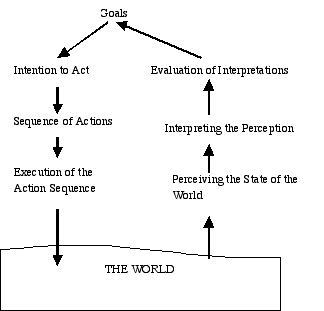
FIT5900 : Lecture
4 – Introduction to HCI
In the previous lecture:
In this lecture:
Q:Why are so many human-made devices so difficult to learn, understand and use?
A: Bad or inappropriate design.
Q: Should users accept bad design?
A: No.
Q: How do we judge quality of design? How do we design better?
A: ?
Human-Computer Interaction (HCI)
Objects that ‘work’ offer a psychology of use that is intuitive and ‘natural’.
Good design defuses the tension between functional and aesthetic goals.
In any real-life situation there are always competing pressures on cost, quality and time.
An Introduction to Cognitive Engineering
|
References:
Norman, D. The Design of Everyday Things, |
Affordance of objects: perceived and actual properties (mainly functional) that determine how the object can be used. Different materials have different natural affordences (that we have learnt largely through our interaction with the world). Balls are for throwing, knobs are for turning, glass is for looking through (and breaking). Complex things require explanation — simple things do not. If simple things require pictures, labels, or instructions, the design has failed. Make the affordances visible.
One estimate states that we "know about" over 30,000 discernable objects.
Constraints — limit the possible ways in which functionality can be interpreted (e.g. holes in scissors vs. functions on a digital watch). The more possible interpretations, the more difficult things are to use.
Mappings — relationships between things. For example: controls, their movements, and the results in the world. (e.g. steering wheel on a car). Natural mapping leads to immediate understanding because it takes advantage of physical analogies (folk physics) and cultural standards: a close and natural relationship between control and function.
|
Physical Analogy |
Cultural Standard |
|
Turning a car wheel Moving a lever up moves the object up (fork lift). |
Rising level means more Lowering level means less Light switch (down is on, up is off in Australia) |
Many good designs also provide appropriate feedback to confirm the users mental model of operation.
The above three qualities arise largely from visual structure. They help build good Conceptual Models: mental models of operation. The users conceptual model may not always match that of the designers. With a good conceptual model, we are able to anticipate and understand the consequences of our actions. When something goes wrong and we do not understand why, then that is a good indication of a bad conceptual model.
The users conceptual model is formed through interaction with the device and the system image (physical structure, including documentation, instructions and labels).
Errors:
The action cycle: execution and evaluation.

Design questions:
|
How Easily Can One: Determine the Function of the Device |
|
|
Tell What Actions are Possible? |
Tell if the System is in the Desired State? |
|
Determine Mapping from Intention to Physical Movement? |
Determine Mapping from System State to Interpretation? |
|
Perform the Action? |
Tell What State the System is In? |
Knowledge
Much knowledge is "in the world" not "in the head". Most of our "in the head" knowledge is vague and imprecise. (e.g. try to remember the layout of the QWERTY Keyboard).
Information a person needs to perform a task: put as much in the world as possible. Use physical and cultural constraints.
Types of knowledge:
Declarative knowledge: knowledge of (facts and rules, e.g. stop at red lights)
Procedural knowledge: knowledge how (process and method, e.g. catch a soccer ball).
Knowledge in the world:
Knowledge in the head:
Applications to Multimedia and User-Interface Design
Visibility: make the functions clear. Differentiate opposing functionality. Use visual function to confirm the users mental model of operation. Sometimes sound can be used to make things ‘visible’ (e.g. vacuum cleaner clogging up).
Feedback: give actions immediate feedback, to reinforce the users mental model.
Design for error — people make mistakes for many reasons. Good design accepts mistakes as a normal part of operation and accommodates them.
• Try to minimize the causes of error by understanding them.
• Make actions reversible (undo).
• Make it easier to discover when errors do occur and make the easier to correct.
• Think of actions as approximations of what is desired, not of user errors.
Forcing Functions — provide constraints of operation in certain situations.
"In theory, an interface designer adopts a metaphor as a means of making the application easier to learn. This theory is based on the premise that the user will be able to transfer his or her knowledge of a familiar object structure to the new application. In practice however, an interface designer often adopts a metaphor as a means of expressing his or her model of how the system is organized. That the metaphor might make the application easier to use is often an after-the-fact and unsubstantiated rationalization of the design." (Interface Hall of Shame)
Summary:
Some web sites of interest:
An understanding of cognitive design can assist in creating high-quality, user-centered objects, interfaces and multimedia.
FIT5900 courseware | FIT5900 lecture notes
©Copyright Alan Dorin & Jon McCormack 1999,2000